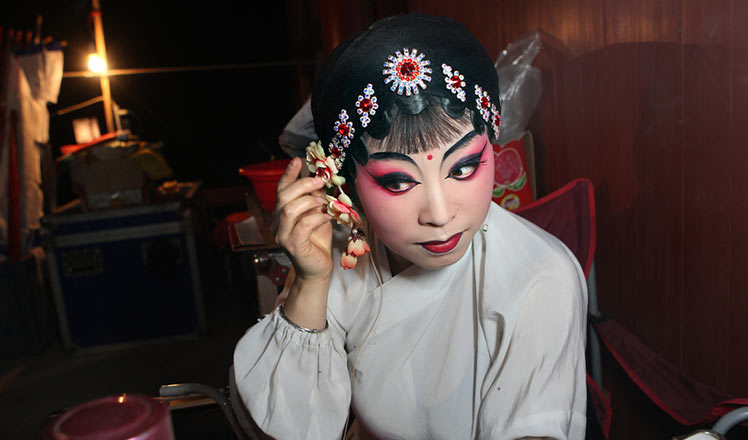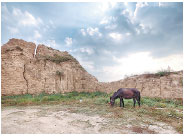Modern ghost town raises spirits of the past
Updated: 2016-11-02 07:29
By Sun Ruisheng and Ren Xiaojin in Datong(China Daily)
|
||||||||
In front of the ancient ruins of the fort stood two gray monuments and a huge gate obscured by a heavy covering of dust and sand. An old man clutching a smoking pipe, which he puffed on at regular intervals, leant against one of the fort's walls, selling bags of apples to passers-by.
A bored donkey chained to a dead tree nibbled on the plants that sprang from the loess soil.
The three Chinese characters engraved on the gate, were barely decipherable. They are de sheng pu, which means "victory town".
The name seemed deeply ironic, given that the only discernable sound in the dilapidated, vacant town was the empty rasping of the wind. The impression conveyed was certainly not one of victory.
"We named this town Victory Town after the Chinese soccer team made it to the World Cup in 1998. We hoped they would be victorious," said the town's only young resident, a local officer that preferred to be anonymous. "It just never happened."
The town was built at the border that separated Ming Dynasty (1368-1644) from the nomadic Mongolian tribes 500 years ago, and it was the first line of defense against outside threats. Now, however, it is simply a ramshackle town that is on the verge of being wiped off the map.
|
Victory Town, with its deathly quiet ancient ruins, attracts visitors who are tired of seeing refurbished ancient sights that are jam-packed with tourists.Attila Balogh / For China Daily |
"I think only 150 people still live in this town," said the young man. "All of the young people have escaped to the city, and now only the elderly remain."
With its shockingly small population, the town and its ancient ruins are deathly quiet. It is this quality, however, that might hold some appeal for tourists who are tired of the seemingly constant parade of refurbished ancient architecture packed with throngs of people. For those looking for the road less traveled and a taste of the old empire, as well as solitude, Deshengpu could be the perfect choice.
On the other side of the gate, is the vast expanse of loess soil where you can find the ruins of the Outer Great Wall. Far from being a magnificent sight like the Great Wall in Beijing, it is just a mass of meandering slopes and hillocks.
There is, however, a sense of past glories reflected in the bleakness of the place, which used to be a flourishing hub of trade, conflict and conspiracy, according to local guide Zhang Lijin.
The top of the arch, which was part of the original wall, has already collapsed. "Under this arch was the border control station, where officials attempted to weed out thieves and conspirators from the honest folk," said Zhang. "And the vast square you can see behind the gate was the horse market."
For hundreds of years, guarded by the walls, Deshengpu has seen few tourists. The villagers warmly welcomed us into their homes, while the shy village dogs hid behind their owners, staring at us with expressions of fear and curiosity.
At dusk, the burning red sunset lit up the drab houses, bringing color to the otherwise dreary town. A woman brandished a scythe to harvest crops. Meanwhile, the old man was still leaning against the fort's walls, and still puffing away at his pipe.
"We hope more people can discover this hidden treasure," said Zhang. "The walls were part of the original structure, they have not been restored or rebuilt. The people here still live simple lives, typical of countryside dwellers. Everything you find here is dripping with history."
- Regular China-South Asia freight train launched
- Police swoop on Paris migrant camp after Calais Jungle clearout
- Regular China-South Asia freight train launched
- South Korean prosecutors arrest woman at centre of political crisis: media
- EU, Canada sign landmark deals to enhance economic, political partnership
- Wife raises funds to search for missing sailor

 Robots draw people to China International Industry Fair
Robots draw people to China International Industry Fair
 German international Miroslav Klose retires
German international Miroslav Klose retires
 Top 10 most influential Japanese cartoons in China
Top 10 most influential Japanese cartoons in China
 Opera performer who takes her shows to villages
Opera performer who takes her shows to villages
 13 most appealing cars in China in 2016
13 most appealing cars in China in 2016
 Obamas host White House Halloween for children
Obamas host White House Halloween for children
 China Fashion Week: Liu Yong Exclusive
China Fashion Week: Liu Yong Exclusive
 Top 5 collaborating countries in Belt and Road Initiatives
Top 5 collaborating countries in Belt and Road Initiatives
Most Viewed
Editor's Picks

|

|

|

|

|

|
Today's Top News
US election rhetoric unlikely to foreshadow future US-China relations
'Zero Hunger Run' held in Rome
Trump outlines anti-terror plan, proposing extreme vetting for immigrants
Phelps puts spotlight on cupping
US launches airstrikes against IS targets in Libya's Sirte
Ministry slams US-Korean THAAD deployment
Two police officers shot at protest in Dallas
Abe's blame game reveals his policies failing to get results
US Weekly

|

|








